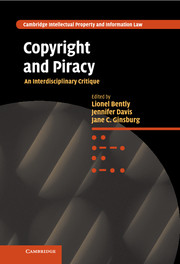Book contents
- Frontmatter
- Contents
- Notes on the contributors
- Editors' preface
- Table of cases
- Table of statutes
- Part I Introduction
- Part II History
- Part III Comparative Law
- Part IV Economics
- Part V Linguistics
- Part VI Computer software
- Part VII Information studies
- 12 Measuring text reuse in the news industry
- 13 Reflections on measuring text reuse from a copyright law perspective
- Part VIII Literature
- Part IX Art
- Part X Sociology/music
- Part XI Criminology
- Bibliography
- Index
- References
13 - Reflections on measuring text reuse from a copyright law perspective
from Part VII - Information studies
Published online by Cambridge University Press: 17 November 2010
- Frontmatter
- Contents
- Notes on the contributors
- Editors' preface
- Table of cases
- Table of statutes
- Part I Introduction
- Part II History
- Part III Comparative Law
- Part IV Economics
- Part V Linguistics
- Part VI Computer software
- Part VII Information studies
- 12 Measuring text reuse in the news industry
- 13 Reflections on measuring text reuse from a copyright law perspective
- Part VIII Literature
- Part IX Art
- Part X Sociology/music
- Part XI Criminology
- Bibliography
- Index
- References
Summary
Introduction
Dr Paul Clough's contribution to this volume (Chapter 12) examines ways of measuring text reuse in respect of material produced by news agency services. It describes the METER project, a project which involved quantifying and measuring the probable reuse of Press Association (PA) material or ‘copy’ in specific stories by members of the British national press. The project used both manual techniques and computational models of measurement, although clearly the real interest is in developing the latter. These computational or automated methods of measuring text reuse could prove useful not only in the sphere of news agency services, but also in other contexts, such as copy detection.
As a UK copyright academic, I found Dr Clough's research interesting in, broadly speaking, two main ways. First, I was struck by the similarities and differences between the concept of text reuse and that of UK copyright law. Second, I was interested in the role computational models of measuring text reuse might have in the copyright sphere.
Translating the concept of text reuse into copyright law
I will start by drawing some comparisons and contrasts between text reuse and UK copyright law. The concept of text reuse does not neatly translate into copyright law terms. First of all, text reuse is confined to written works or documents and ignores other types of media, such as film, music and artworks, which do fall within the purview of copyright law.
- Type
- Chapter
- Information
- Copyright and PiracyAn Interdisciplinary Critique, pp. 260 - 268Publisher: Cambridge University PressPrint publication year: 2010
References
- 1
- Cited by



